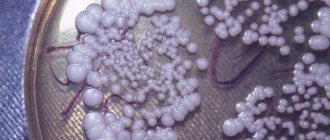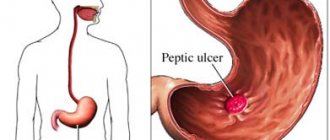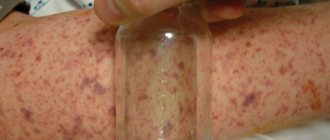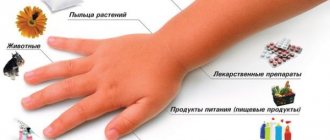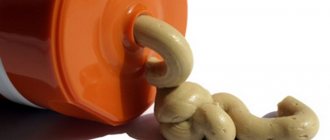Recently, the child (4.5 months) began to go to the toilet very strangely. In the diaper I find a lot of black dots in the stool every time. Like sand or poppy. I’m thinking: should I sound the alarm and run to get tested or is this normal? The baby is completely breastfed.
Has your diet changed? Black spots in a child's stool may be undigested calcium or iron. Perhaps you are taking some vitamins? Try (for a child) to take a coprogram (general stool analysis), there is such an indicator - detritus, which means the presence in the stool of a mass of small particles of various sizes and shapes. These particles consist of breakdown products of food residues, bacteria, and some cells.
There is an opinion of many experienced mothers who have raised more than one that you don’t need to pay attention to poop until the child is crying due to abdominal pain.
And I draw your attention to the fact that this is the opinion only of those who have more than one child. They have to react only when their child cries, because they don’t have enough to do anything else. There is no extra time or nerves. A comfortable position, but it can be fatal for the baby.
Let me tell you right away that not all moms are like this. And those with many children manage to sift out from everything that happens to their children something important that cannot be missed.
If you value your child, you should not follow a negative example. Notice and react to any manifestation of the child’s body, just do it smartly, without fuss, because the younger the baby, the easier it is to cope with the disease. You should not leave any problem unresolved, because it may develop into a chronic form or pathology in the future.
My granddaughter had what you describe when she was six months old. Still a baby. It turned out that these were worms. There was a cat in the apartment, the child came into contact with it, the adults did not notice when the child put his fingers in his mouth. And here is the result. This also happens when breastfeeding. And just in case, check yourself for worms. And go for a consultation with a gastroenterologist (even a paid one), taking the child’s feces.
Based on the feces leaving the body, one can draw a certain conclusion about the processes occurring in it. That is why it is so important for parents to regularly monitor the type of children's excrement, its consistency, composition, possible inclusions, etc.
Particles of black or white color with a consistency that is not typical for normal feces, especially in a small child, cause understandable anxiety in parents.
What to do in such a situation? To get started, we recommend reading this article. This article describes in detail methods of controlling parasites. We also recommend that you consult a specialist. Read the article >>>
You can often see this in a child’s stool
The first thing that comes to their mind is worms. Young children are especially susceptible to helminthic infestation, as they rarely observe personal hygiene rules. However, do not rush to panic - in most cases, if you find black threads in a child’s stool, as in the photo below, this has nothing to do with worms.
Another photo of feces with unusual inclusions
Please note that science does not know of any human parasite that has a thread-like shape and a dark color. Typically, worms have a whitish-yellowish coloration, because, living inside the human body, they do not have to attract individuals of the opposite sex with the help of color or frighten enemies with it. So the idea of black worms can be safely discarded.
Of course, under no circumstances should black threads in the stool be ignored. Try to remember what your child ate in the previous three days and carefully monitor the appearance of stool over the next few days, and also write down everything you give your child. This is especially true for infants and children about one year old, who are given complementary foods in the form of fruits, berries, etc.
What could be black strings in a child’s stool?
The structure of the digestive system in children is somewhat different than in adults, and it happens that some foods are not completely absorbed.
Most often, black strings appear in poop for the following, completely natural reasons:
- The baby was fed a banana, apple, pear, kiwi or prune, and not necessarily on that day, maybe the day before. These products contain a lot of iron, and the child’s fragile gastrointestinal tract is not yet able to ensure its complete absorption, which manifests itself in the form of dark threads in the stool. Over time, iron absorption normalizes;
- A similar effect is achieved by baby food fortified with iron;
- If the child takes certain medications, primarily iron-containing ones, which are often prescribed, for example, for anemia.
Grains in stool
Normal stool in a formula-fed baby looks like a thick porridge, and the color is close to brown. The transition from natural nutrition to mixed, and then to artificial food for the intestines is not so easy. The introduction of complementary foods to a 4-month-old baby also changes feces. The body digests new food reluctantly, therefore, at first it simply passes everything swallowed through the intestines, absorbing almost nothing from it. You can find in the stool what you gave your baby to eat 2 days ago.
If nutritional mixtures contain a lot of iron, then its oxidation in the intestines causes stool to turn black.
The black color of stool can be caused by foods contained in complementary foods, which contain a lot of iron. These include:
- beet;
- dark-colored berries and fruits (currants, blackberries, cherries, prunes, apples, pomegranates);
- offal (liver, heart, kidneys).
The chair can be partially changed. If you have just recently started introducing complementary foods, then various inclusions in the stool are completely normal.
Grains of sand and grains are pieces of undigested food. This chair with numerous black fibers resembles a carpet. Seeds and pieces of fruit skin, as well as undigested meat fibers, appear as streaks in dark-colored stool. Gradually, the child’s body will learn to digest such food. Sometimes mothers notice black threads in the stool that resemble worms. These are traces of a recently eaten banana. Unlike these stripes, intestinal worms are not black in color. They are always white or yellowish.
Taking some medications is also accompanied by darkening of the stool. These are activated carbon, dietary supplements and vitamin complexes containing iron. At 2 years old, the feces are already quite hard and brown in color. Children aged 5 years are more likely to experience constipation. Mothers give their children laxatives or activated charcoal. The effect is liquid, dark-colored stool. There is no need to be afraid. This is due to the presence of that same iron in the medications taken.
Doctor Komarovsky's opinion
Dr. Komarovsky, who is perhaps the main authority in the field of pediatrics for all mothers, believes that when examining a child under one year old, a pediatrician should definitely inquire about his stool, since the characteristics of the stool are a very informative indicator of the baby’s health.
Changing the nature of stool, according to Dr. Komarovsky, is a completely natural process, and it begins from the moment of birth. First of all, meconium comes out of the newborn’s body, and then the characteristics of feces are determined by the type of feeding - breast or artificial.
In general, normal stool in infants is a flexible concept, since each baby may have its own norm. It is important to carefully monitor both the child as a whole and his stool. Based on its appearance, certain conclusions can be drawn:
- The appearance of a large number of white cheesy lumps indicates overeating - an excess of breast milk or formula that the digestive system does not have time to process.
- The presence of mucus in the stool of infants, according to Dr. Komarovsky, is normal, but he recommends monitoring the frequency of mucus and its volume and carefully monitoring the child’s general condition.
- If the feces have turned black, Dr. Komarovsky recommends urgently consulting a doctor. This color may be a consequence of taking certain medications, for example, antibiotics or activated carbon, but if the child did not take them, then the pediatrician must figure out the reason.
If your child has this color of stool, consult a doctor immediately
When complementary foods are introduced, changes in stool patterns occur again. During the period of adaptation of the digestive system, that is, getting used to new types of food, lumps of undigested food, mucus and even bloody streaks may be observed in the stool of infants.
This usually frightens mothers very much, but they should pay attention to the baby’s behavior: if he feels well, eats well, sleeps soundly, and is active during periods of wakefulness, then everything is fine, and changes in stool are not caused by any disease.
If such stool is accompanied by fever, nausea and vomiting, diarrhea or constipation, skin rashes, sleep and appetite disturbances, restless behavior and weight loss, then this requires immediate consultation with a doctor.
Perhaps the child is allergic to certain foods, or his body does not digest them well or does not tolerate them at all, or some errors were made in feeding - your pediatrician will help you figure out why this is happening.
By the way, Dr. Komarovsky names specific foods, frequent consumption of which can cause the appearance of dark spots in the stool, and not only in infants. These are eggs, liver and other offal. Adjust the child’s menu, reduce the amount of these products, and everything will return to normal.
When not to worry
The digestive tract of a small child is not yet capable of digesting food “like an adult.” For this reason, some foods are only partially absorbed by the child’s body or are completely rejected, and as a result are excreted along with the feces.
The presence of dark “worms” in the stool of an infant or older child is a consequence of the use of:
- Apples, persimmons, bananas, pears, kiwis, pineapples, grapes, black currants, beets, broccoli, poppy seeds and other foods containing iron;
- Iron-containing vitamins and various medications.
On a note. The likelihood of black fluff appearing increases if the product was introduced into the child’s diet for the first time since birth. In older children, a similar symptom is observed if they eat large amounts of kiwi or persimmon. Undigested iron particles can come out not only in the form of black threads, but also tiny inclusions, resembling a poppy seed in shape and size.
READ ALSO: Is a boil contagious or not: is it passed on in the family, is it inherited |
If the baby is breastfed, the occurrence of such particles in the stool can be explained by the diet of the nursing mother. If a woman ate a large amount of bananas before lactation, then breast milk will absorb a significant amount of iron. As a result of feeding, the baby’s body receives a certain amount of this substance, but it is not yet able to digest even such a small amount.
Black feces in a newborn can be explained by the passage of meconium in the baby in the first days of his life. Original feces are colored black-green. As the child's intestines are cleared of meconium, the color of the stool changes, but black spots may remain for some time.
On a note. If the cause of the appearance of strings is related to the diet of the child or his mother, there is no need to limit the consumption of iron-containing products, since this symptom does not pose a danger to the baby’s health.
Another harmless cause is the child swallowing hair and other foreign objects. Children aged 4-5 months actively taste the things around them, so they can easily swallow their own hair, a piece of dog hair, etc.
In addition to iron-containing foods, children's intestines have difficulty digesting carrots. Pieces of the vegetable may come out along with the feces and resemble dark threads.
Dark “worms” often appear as a result of taking certain medications, the remains of which are excreted from the body along with feces. So, threads appear after taking the following medications:
- Sorbents (for example, activated carbon);
- Vitamins in combination with various microelements;
- Drugs whose action is aimed at increasing hemoglobin in the blood.
Most often, after taking sorbents, the stool turns completely black. This effect is natural, since this type of medicine cleanses the body of waste and toxins, along with which it comes out in the form of black feces. Thus, you should not refuse to take medications for this reason.
In some cases, children are prescribed bacteria to form intestinal microflora (for example, bifidumbacterin). As a result of this therapy, black “worms” may appear in the stool (as a result of establishing a bacterial balance).
Quite often, young children suffer from anemia (anemia), which is caused by a low level of hemoglobin in the blood. To replenish the missing element, the child is prescribed a course of taking iron in the form of tablets or syrup. Since the substance is poorly digested by the children's intestines, some of the iron comes out along with the feces in the form of black lumps.
Iron-containing foods often cause black threads to appear in a child’s stool.
READ ALSO: Lump in the groin in men, left or right - photo and 4 reasons
Why might a child have black strings in his stool?
Helminth infections can lead to numerous health problems, shortening life by 15-25 years. Many parasites are extremely difficult to detect. They can be anywhere - in the blood, intestines, lungs, heart, brain. Symptoms of helminthic infestation can be confused with ARVI, gastrointestinal diseases and others. The main mistake in such cases is delay! If you suspect the presence of parasites, you need to contact a specialist. More information about modern methods of treating helminth infections is described in this interview with a doctor. If we talk about medications and self-treatment, then this antiparasitic complex is suitable for the most common helminths (ascaris, pinworms, tapeworms).
As you can see, most often the appearance of such threads in a child’s feces is associated with iron. When his body is fully formed and is capable of completely breaking down, digesting and assimilating complex or heavy substances that come with food, these phenomena will stop.
In the meantime, it can be considered completely normal if black strings, grains or undigested pieces of food are found in the diaper, especially if this happened after the introduction of a new infant formula with a high iron content. This is within the age-related physiological norm and does not require treatment; You should also not exclude this product from your baby’s diet.
Causes
White, hard grains in a baby's stool are a fairly common occurrence. Sometimes the grains look like pieces of cottage cheese or the remains of sour milk. They are particles of undigested food and may also consist of plant residues.
The appearance of such inclusions does not require therapy, unlike the appearance of white veins.
In the latter case, the cause lies in infections caused by candidiasis or intestinal dysbiosis. As a result of such disorders, the intestinal mucosa becomes covered with a white coating that ends up in the feces.
White streaks in feces are an alarming signal, and it concerns not only children, but also adults. Self-medication in this case is contraindicated and you cannot do without consulting a gastroenterologist!
Returning to white grains, it should be remembered that their appearance is often associated with overeating and the child gains significant weight. Mothers are advised to put their baby to the breast on demand. That is, regardless of the last meal.
This is especially often required for children who are characterized by capricious behavior. As a result, the toddler overeats, and a certain amount of proteins and fats do not have time to be digested, appearing in the feces of infants in the form of white flakes or hard lumps. There is absolutely nothing wrong with this, since such manifestations occur in most children.
It is possible to defeat parasites!
Antiparasitic Complex® - Reliable and safe removal of parasites in 21 days!
- The composition includes only natural ingredients;
- Does not cause side effects;
- Absolutely safe;
- Protects the liver, heart, lungs, stomach, skin from parasites;
- Removes waste products of parasites from the body.
- Effectively destroys most types of helminths in 21 days.
There is now a preferential program for free packaging. Read expert opinion.

The best stories from our readers
Topic: Parasites are to blame for all troubles!
From: Lyudmila S. ( [email protected] )
To: Administration Noparasites.ru
Not long ago my health condition worsened. I began to feel constant fatigue, headaches, laziness and some kind of endless apathy appeared. Problems also appeared with the gastrointestinal tract: bloating, diarrhea, pain and bad breath.
I thought it was because of the hard work and hoped that it would go away on its own. But every day I felt worse. The doctors couldn’t really say anything either. Everything seems to be normal, but I feel like my body is not healthy.
I decided to go to a private clinic. Here I was advised, in addition to general tests, to get tested for parasites. So in one of the tests they found parasites in me. According to doctors, these were worms, which 90% of people have and almost everyone is infected, to a greater or lesser extent.
I was prescribed a course of antiparasitic medications. But it didn’t give me any results. A week later, a friend sent me a link to an article where some parasitologist shared real tips on fighting parasites. This article literally saved my life. I followed all the advice that was there and after a couple of days I felt much better!
Digestion improved, headaches went away and the vital energy that I so lacked appeared. To be sure, I took the tests again and no parasites were found!
Anyone who wants to cleanse their body of parasites, no matter what types of these creatures live in you, read this article, I’m 100% sure it will help you! Go to article>>>
Medical statistics show that children's stool is mostly black due to certain foods and medications. Much less often, a black tint to the stool appears as a result of painful processes occurring in the child’s body. If parents notice black feces in a child that is not accompanied by general malaise, then there is no reason to worry. If you add negative symptoms in the form of fever, weakness, diarrhea, you should seek help from a doctor.
Causes of black stool in children of different ages
Fortunately, in children, diseases that can cause bleeding and the associated appearance of black feces are much less common than in adults, so if you notice that your child has released black feces, there is no need to panic. As will be shown below, this can be a completely normal phenomenon.
Black feces in a newborn baby
Black, and in some cases black-green, liquid stool that is released in the first days after birth is completely normal for newborn babies and should not cause any concern. Such stool in newborns is called original feces (medical name is meconium
).
After some time, meconium is gradually replaced by normal feces, which, depending on the type of food the baby is fed (breast milk or formula), can be light yellow or mustard in color, liquid, with white lumps, small amounts of mucus and a characteristic sour or unpleasant odor.
Many parents consider such liquid feces to be diarrhea, but this is completely wrong. This is what normal feces should be like in a newborn baby.
Black feces in a baby
In infants, the cause of the appearance of black feces can be iron contained in artificial formulas, vitamins, as well as various foods that the child receives in the form of complementary foods.
In all cases where black feces (or feces with black inclusions) appear in a child who appears healthy in appearance, eats well and sleeps well, there is no need to worry.
On the contrary, if after the appearance of black feces the child seems sick to you, be sure to show him to the doctor. In such a situation, additional examinations may be needed to determine the cause of the disease.
Now there are over 260 species of helminths, in addition to worms that live in exotic countries. Helminths oppress the human body by feeding from the inside with microelements and other nutrients.
Methods to control worms are known if the worms are found in the stool and are clear or white in color. But when black worms are found in stool, it causes surprise and confusion. People often wonder whether helminths are black in color.
It should be immediately noted that the concept of “black worms” is incorrect, since helminths of this color do not exist in nature. However, the question arises: why do some people still see black worms in their stool?
Before you panic about such an original color of helminths, you should first understand whether the inclusions in the stool are actually worms.
Often what people think of as black worms are actually undigested banana fiber particles. This is easy to check if there are dark spots and motionless strings in the stool. If the black worms in the feces are banana fibers, the next bowel movement the color of the feces is completely normal and there are no strings.
At the same time, if there are symptoms indicating a helminthic infestation, it is imperative to carry out research.
You should check your body with:
- scraping for enterobiasis,
- coprogram,
- examination of stool for helminth eggs.
Testing stool for worm eggs at home does not guarantee their detection. This type of research has limitations. The fact is that helminths lay eggs at regular intervals, and not every day. Thus, during the study, helminths can simply “rest”, and it will not be clear what type of worms a person has, and whether they exist at all.
Black worms in humans can be:
- Nematodes,
- Trematodes or flukes,
- Extraintestinal,
- Intestinal.
Regardless of the research method, the rules for collecting stool are the same. To get an objective result, feces must be collected in a dry and clean container. The material should be studied no later than an hour later.
At home, you can use a magnifying glass. The procedure is carried out every one or two days for several weeks. Laboratories also perform scrapings from the anus, which can be done with a cotton swab at home. The stick for use in the laboratory must be sealed. The analysis is submitted no later than 24 hours later if the container was stored in the refrigerator during this time.
Any tests should be done several times to ensure the reliability of the result.
The main symptoms of the presence of helminths include:
- Sleep disorders
- Itching in the anal area,
- Constipation or loose stools
- Nausea,
- Skin rashes,
- General weakness
- Increase in temperature.
Black worms look quite scary. A person can also find eggs and black-headed worms in their stool. In these cases, you should immediately submit the material for analysis.
Black or brown worms in the stool are possible when eating fiber foods. The human stomach may not always be able to fully cope with the digestion of food. Food fibers undergo oxidation in the stomach and are excreted in the feces in the form of dots and black stripes.
As a rule, the person’s stool becomes normal within the next day. However, when there are repeated brown spots in the stool, this may indicate that internal bleeding is present. In this case, you should immediately visit a doctor.
Why is baby's stool black?
When establishing the causes of black feces, pediatricians rely on the age of the child. For a 1-3 week old newborn, feces with black spots are considered physiological norm. In fact, experts call the first bowel movements of babies not even feces, but meconium, for which the natural color is black or green.
The presence of mucus and white lumps in the feces of infants is also considered normal. The formation of digestion and a new diet transform meconium into normal stool, which has the usual light brown, yellow or white-yellow color.
Is this normal?
For babies this is an ordinary physiological process. During the process of intestinal formation, children's feces vary. The appearance of blackheads is also considered normal. Especially during the inclusion of complementary foods. Over time, the body gets used to certain foods, and with age, the digestive system copes well and completely with digesting them.
The presence of black threads in the stool does not require a trip to the doctor and special treatment if the baby feels normal.
Based on the feces leaving the body, one can draw a certain conclusion about the processes occurring in it. That is why it is so important for parents to regularly monitor the type of children's excrement, its consistency, composition, possible inclusions, etc.
Particles of black or white color with a consistency that is not typical for normal feces, especially in a small child, cause understandable anxiety in parents.
What to do? To begin with, we recommend reading an article from the main institute of parasitology of the Russian Federation. This article reveals a method by which you can cleanse your body of parasites, without harm to the body. Read the article >>>
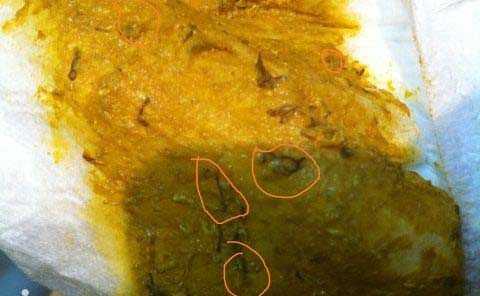
You can often see this in a child’s stool
The first thing that comes to their mind is worms. Young children are especially susceptible to helminthic infestation, as they rarely observe personal hygiene rules. However, do not rush to panic - in most cases, if you find black threads in a child’s stool, as in the photo below, this has nothing to do with worms.
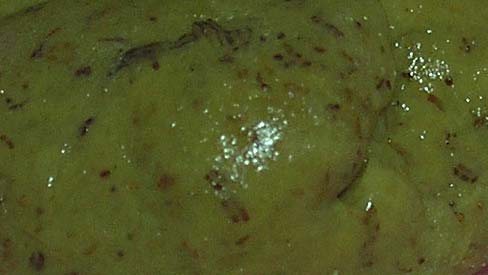
Another photo of feces with unusual inclusions
Please note that science does not know of any human parasite that has a thread-like shape and a dark color. Typically, worms have a whitish-yellowish coloration, because, living inside the human body, they do not have to attract individuals of the opposite sex with the help of color or frighten enemies with it. So the idea of black worms can be safely discarded.
Of course, under no circumstances should black threads in the stool be ignored. Try to remember what your child ate in the previous three days and carefully monitor the appearance of stool over the next few days, and also write down everything you give your child. This is especially true for infants and children about one year old, who are given complementary foods in the form of fruits, berries, etc.
What diseases cause black stool?
Black stool in children aged 3-6 years, schoolchildren and teenagers signals problems in the body. Let's find out what diseases cause black-green feces:
- Food poisoning. Serious intoxication of the body occurs, diarrhea appears, and the feces turn dark green or black. The child complains of pain in the lower abdomen, headaches, and nausea.
- Colitis. The disease is caused by an inflammatory process in the intestines that occurs due to a bacterial infection. The disease can be identified by symptoms such as severe abdominal pain, high fever, vomiting, loose dark stools, and often black diarrhea.
- Diverticulitis is an intense intestinal infection. The disease is characterized by the formation of hernias on the intestinal walls. Stool takes on a dark color when the intestinal wall becomes inflamed, hernias burst, and blood particles enter the intestines. Loss of appetite, nausea, vomiting, and diarrhea are added.
- Internal bleeding. A factor requiring immediate medical intervention. The specialist will find out the causes of bleeding and draw up a treatment plan.
Causes of black stool in adults
We have already said above that the main reason for the appearance of black stool in children and adults is the consumption of food and medications, which, passing through the intestines, give the stool a uniform or, more often, granular black color.
Stool with black dots (black specks in stool, black grains, black threads, black grains, sand)
Black inclusions of various shapes in stool are almost always partially digested remains of food or medicine. Seeds and fragments of the peel of fruits and berries (for example, raspberries, currants, grapes) may appear as black grains.
In the intestines, foods that have a different color before being eaten can acquire a dark color.
Black worms in stool
Black inclusions in stool (especially common in children), which look like “black worms,” may appear after eating a banana.
Many people mistake them for worms and even go to the doctor about this in order to take a stool test and undergo treatment.
Liquid black stool (black diarrhea)
Most often, the appearance of black liquid stool (black diarrhea) in an adult is a consequence of internal bleeding from the esophagus, stomach or intestines, caused by an ulcer, cancer, polyps or dilated veins of the esophagus.
In the human stomach and intestines, blood is decomposed by digestive enzymes and bacteria, which changes its color from red to black.
Other signs of bleeding may include weakness, paleness, dizziness, and anemia (low hemoglobin levels).
Black stool mixed with blood
Black stool mixed with blood can be caused by some serious intestinal diseases (for example, Crohn's disease), so if such a symptom appears, you should consult a doctor as soon as possible. If in your case there is really noticeable blood in your stool, read our recommendations in the article.
Black stool after surgery
The appearance of black stools after surgery can also be a sign of internal bleeding (especially if the operation was performed on the stomach or intestines).
Fever + black-green diarrhea
The appearance of fever and black-green diarrhea may be a sign of an intestinal infection.
Black feces during pregnancy and after childbirth
Pregnancy and childbirth do not have a direct effect on the functioning and condition of the stomach and intestines, and therefore cannot be the direct causes of black stools.
In pregnant women, as well as after childbirth, the reasons for the appearance of black stools may be the above diseases, medications and foods.
What should parents be concerned about?
Professional recommendations from pediatricians will help you correctly assess the situation and take appropriate measures. To determine the harmlessness or severity of a condition, you should:
- Assess the child's condition. Try to analyze and remember what kind of food the baby received, what medications he took for several days. An increase in temperature, nausea, abdominal pain, pale skin is a direct signal to seek medical help.
- Monitor the duration of dark stool appearance. If after 1-2 days the stool has acquired its usual color, parents have no reason to worry. Frequent manifestations of black-green stool require contacting a pediatrician.
- If you have any suspicions related to taking certain medications,
What to do?
If, during the next diaper change, black threads resembling worms are found, you need to pay attention to the following points:
- The emotional state of the child is smiling, playful, good mood.
- Physical well-being – no fever, soft, non-painful abdomen, clean skin, normal stool.
- Proper nutrition - no errors in feeding, regimen.
- Availability of certain products - apple, pear, banana, kiwi, persimmon.
If all these components are present, the appearance of black threads in the stool should not cause concern to parents; the child is completely healthy.
If you feel unwell and have dark threads in the form of worms for several days, you should consult your pediatrician. After performing a physical examination of the child and studying the tests, the doctor will be able to establish the correct diagnosis and prescribe the necessary treatment.
Until this moment, you should not mistake black threads in children’s stool for worms and self-medicate.
